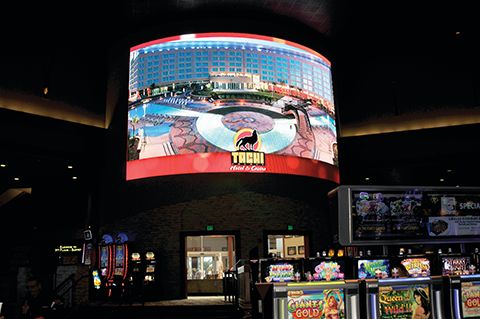Digital Signage: Why pixel pitch matters
by all | 11 September 2015 10:28 am
Photos courtesy Nanolumens
By Brett Farley
Terms like high-resolution, high-definition (HD), ‘4K’ ultra-high-definition (UHD), Widescreen Ultra Extended Graphics Array (WUXGA), pixel density and pixel pitch get tossed around a great deal these days with regard to digital signage. It is important to demystify and place these terms into the proper context when investigating display technology for a particular application or project.
Audiovisual (AV) professionals frequently ask questions that are essentially misdirected—such as “Is the display HD?”—when trying to determine whether or not a light- emitting diode (LED) display of particular dimensions will deliver the content clarity and sharpness they require for a given application. Their miscues are largely a result of their comfort in using terminology inherited from liquid crystal display (LCD) technology. It is time to help clarify the world of LED screen pixel pitch and density, so sign customers can obtain the real value of the technology’s features and benefits.
Resolution vs. definition
HD is a relative and often catch-all term for high-resolution when describing the clarity and sharpness needed for the viewing of specific content, as it does measure resolution, i.e. the fineness of detail that can be distinguished in an image. For high-resolution content to be considered HD, however, it must meet three specific criteria:
- Widescreen format incorporating the 16:9 aspect ratio.
- Resolution of 1,920 x 1,080 pixels.
- Frame rate between 24 and 30 frames-per-second (FPS).
Such constraints were created as units of standardization for the AV industry, but they are not necessarily optimal for every situation, in terms of the display used and the content presented.
 [2]
[2]LED screens are sometimes unfairly judged using terminology inherited from LCD technology.
By way of example, for a 4-mm (0.16-in.) pixel-pitch LED display to be truly HD, it would have to be at least 9.4 m (30 ft) wide. And if the pixel pitch were increased to 6 mm (0.24 in.), the same display would have to be at least 12.4 m (40 ft) wide.
As for ‘4K’ ultra-high-definition (UHD), which is four times the resolution of true HD, what previously would have been impractically huge is beginning to become practical through the use of displays with less than 2-mm (0.08-in.) pixel pitch. A 1.8-mm (0.07-in.) pixel- pitch 4K/UHD display, for example, would be 6.9 m (22.6 ft) across, which could be accommodated in many of today’s sports bars.
‘High-resolution,’ on the other hand, is specific, as it can refer to any display with sharp, clear and finely detailed resolution, whether or not it is true HD. It is also a more appropriate term for LED displays which, unlike traditional LCDs, are not bounded by the forced form factor of an HD 16:9 aspect ratio or 1,920 x 1,080 pixels.
It is more realistic to show high-resolution content on an LED display based on the number of pixels (i.e. the pixel matrix) and the quality of the LED lamps. High-resolution content can certainly be scaled for effective display on such an array.
Pitching pixels
Based on the term ‘picture element,’ a pixel is the smallest addressable (i.e. by its physical co-ordinates) and controllable element of a digital display. For both LCDs and LED screens, pixels are manufactured in a two-dimensional (2-D) grid, often represented as dots or squares.
The concept of pixel pitch and density is similar to printed images, where resolution is measured in dots per inch (dpi). Pictures in magazines, for example, tend to look better than those in newspapers because magazines are produced at higher dpi.
Each pixel in a screen displays a ‘sample’ of an original image. More samples, typically, will provide more accurate representations of the original.
The intensity of each pixel is variable. Their colours are typically represented by three or four component intensities, such as red, green, and blue (RGB) or cyan, magenta, yellow and key/black (CMYK).
With discrete or surface-mounted device (SMD) LED displays, each pixel is actually an LED lamp comprising three ‘sub-pixel’ diodes to provide RGB colours. In this context, pixel pitch refers to the horizontal or vertical distance between the centres of each discrete LED lamp.
 [3]
[3]The widescreen format incorporates a 16:9 aspect ratio.
With this in mind, when AV professionals ask about the pixel pitch of a given LED display, they are asking how clear their images will appear on the display. This depends, however, on (a) the nature of the content and (b) the minimum distance at which the audience is likely to view the content.
Given the variability of such factors, it is worthwhile to compare a few scenarios where LED display technology might be deployed.
Scenario 1
The display will feature a ‘rotation’ of advertising images and text to quickly inform customers entering a retail environment about current sales and promoted product lines. Specifically, it will be mounted above the entrance, where customers will glance at it for perhaps 10 to 15 seconds on their way into the store. Realistically, the minimum viewing distance will be 4.6 m (15 ft).
Scenario 2
The display will be mounted behind a bar in a holiday resort to show HD simulcasts of sports and concerts, with the goal of simulating—to the nearest extent possible—the experience of viewing the events live and in person. The duration of viewing, for each member of the audience, is likely between 15 minutes and three hours. The minimum viewing distance is 3 m (10 ft), but the vast majority of viewers will be 5.5 to 6.1 m (18 to 20 ft) or even further away.
These two scenarios differ in terms of (a) the intended content, (b) the required resolution, (c) the average length of audience exposure and (d) the minimum viewing distance. All of these factors will directly inform the choice of the appropriate pixel pitch for each LED display.
 [4]
[4]Click to enlarge
Minimum viewing distance
Depending on the pixel pitch of the display, as someone approaches it, a certain minimum viewing distance is required without the image becoming too ‘pixelated.’ At that distance, the average human eye cannot discern the individual pixels of the display.
As a general rule of thumb, the minimum viewing distance in feet is roughly three times the pixel pitch in millimetres. So, the minimum viewing distance for a display with 5-mm (0.2-in.) pixel pitch would be about 4.6 m (15 ft). Chart 1 lists suitable ranges.
With LED displays, the minimum viewing distance can also depend on the overall surface area. For example, if a display is 6.1 x 4.9 m (20 x 16 ft), it will use far more pixels to replicate an image than a 3 x 2.4 m (10 x 8-ft) display, providing more information for the eye to process and thereby increasing the perception of resolution. Since such displays use light-emitting rather than light-reflecting technology, the gaps between their pixels tend to ‘soften’ and are perceived as less distinct by the human eye.
Optimal viewing distance
While it is useful to calculate an LED display’s minimum viewing distance, a more important consideration is its optimal viewing distance, at which point the image will appear the most clear to the average viewer. The larger the pixel pitch and the lower the pixel density, the further the optimum viewing distance; and conversely, the smaller the pixel pitch and the higher the pixel density, the shorter the optimum viewing distance.
One of the most familiar examples is how drivers view digital billboards along their daily commute. From their substantial viewing distance, graphics appear as crisp, solid images and words are easy to read. If they were to get out of their cars, climb up to a billboard and examine it closely, they would find it impossible to see the images at all. Rather, they would see hundreds of pixels spaced 10 to 30 mm (0.4 to 1.2 in.) from each other.
The average 4.3 x 14.6-m (14 x 48-ft) billboard features just over 150,000 pixels. This is actually far less than a typical 1.4 x 2.5-m (55 x 98-in.) display with 6-mm (0.24-in.) pixel pitch and a 16:9 aspect ratio; but as viewing distance increases, the respective colours of neighbouring pixels appear to blend together, merging to form a single image.
 [5]
[5]When selecting an LED display for a given environment, it is important to understand the distances from which it will be viewed.
Further, ‘resolving distance’ is most accurately defined in terms of the viewing angle. A person’s field of view is expressed as an arc created by the triangle of which he/she stands at the vertex, but the average human eye can only resolve one sixtieth (1/60) of a degree of this arc.
As an individual’s distance from a display increases, the ‘arms’ of his/her field of view become longer, with their termination points father apart, such that the resolvable portion of the arc contains more information. In other words, as one moves farther away from a billboard, the more easily one is able to resolve its entire display area as a crisp, clear, cohesive image.
Choosing the right display resolution, pixel pitch and pixel density is somewhat subjective, based on the size of the display, but in any case, it is important to ensure the actual viewing distance will be the same or greater than the display’s optimum viewing distance.
Content and pixelation tolerance
Going back to the situations mentioned earlier, the content in Scenario 1 is intended to be quickly consumed and processed in passing, to help influence the viewer’s purchasing habits in the store. The information conveyed is more important than the clarity or resolution of the images. The graphics will still need to be eye-catching and flashy, of course, but the tolerance for pixelation is relatively high.
 [6]
[6]In a less open indoor environment, such as a sports bar, the average viewing distance will be relatively short.
The content in Scenario 2, on the other hand, is intended to attract, capture, hold and entertain customers at the resort bar for an extended period, during which they may consume food and beverages and encourage acquaintances to do the same, generating revenue for the facility. The tolerance for pixelation will be significantly lower than in Scenario 1.
Costs
When the pixel pitch for a given display area is reduced, the number of individual LEDs in that area is increased, translating into higher costs. In many applications, this is why pixel pitch becomes an important consideration. Digital signage operators may well adjust their expectations and find compromises in what can be done affordably.
So, the higher the resolution, the higher the cost of the display, due to the higher number of LEDs—but as described earlier, it is important to choose the right display based on the application conditions, not based on resolution alone.
Further, not all LED displays are created equal. A 4-mm (0.16-in.) pixel pitch display from one manufacturer will not necessarily produce the exact same image as one from another manufacturer.
It is important to perform an actual visual evaluation of each display under consideration. In addition to the factors mentioned herein, displays will also vary in brightness, colour contrast, off-axis viewing angle, power consumption and total cost of ownership (TCO).
Brett Farley is director of sales and demand development for NanoLumens, which manufactures slim, light, energy-efficient LED displays. For more information, visit www.nanolumens.com[7].
- [Image]: http://www.signmedia.ca/wp-content/uploads/2015/09/pixel_1.8_2.jpg
- [Image]: http://www.signmedia.ca/wp-content/uploads/2015/09/Nano_CenturyLink9.jpg
- [Image]: http://www.signmedia.ca/wp-content/uploads/2015/09/Tachi-Palace.jpg
- [Image]: http://www.signmedia.ca/wp-content/uploads/2015/09/Chart-1.jpg
- [Image]: http://www.signmedia.ca/wp-content/uploads/2015/09/Standsted-Airport.jpg
- [Image]: http://www.signmedia.ca/wp-content/uploads/2015/09/TD-Garden-02.jpg
- www.nanolumens.com: http://www.nanolumens.com
Source URL: https://www.signmedia.ca/digital-signage-why-pixel-pitch-matters/